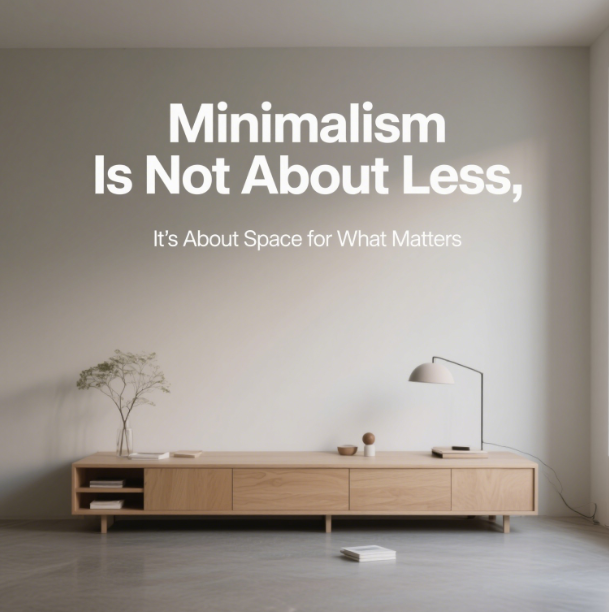Minimalism often gets mistaken for a war against things. Fewer clothes. Sparse furniture. White walls. It’s become synonymous with living in a kind of permanent decluttering challenge—cutting out, stripping back, reducing, reducing, reducing. But the heart of minimalism isn’t about owning the fewest possible items or fitting your life into a carry-on suitcase.
Minimalism, in its essence, is about creating space—space not just in your closet, but in your life. It’s about clearing away the noise so that the signal can come through. It’s not about less for the sake of less, but about less so you can focus on more of what matters.
Reframing the Definition
If you’ve ever looked at a minimalist’s Instagram feed, you’ve likely seen endless photos of clean desks, empty shelves, and neutral tones. While aesthetically pleasing, this image of minimalism can be misleading. It tells a story of absence, but not of intention. The truth is, minimalism isn’t about austerity—it’s about alignment.
Think of it like pruning a tree. You’re not cutting branches because you hate trees; you’re doing it so the tree can grow in the right direction. You’re removing the nonessential not because it’s bad, but because it’s not the priority. You’re giving your energy, your time, your attention the space it needs to go deeper, not wider.
Making Room to Be Present
In a world obsessed with productivity and optimization, minimalism is a gentle rebellion. It says: “What if I didn’t try to do more, have more, be more all the time? What if I paused to consider what actually matters to me?”
That’s a radical shift. Because once you begin to examine your life through that lens, you realize how often we fill it with things—objects, commitments, information—that don’t actually contribute to our happiness or growth. We scroll through apps we don’t need. We agree to meetings that sap our energy. We chase achievements that don’t feel like our own.
Minimalism invites us to ask better questions:
- Is this adding value to my life, or just taking up space?
- Is this commitment aligned with my values, or am I saying yes out of guilt?
- Is this noise or signal?
And when you start to clear away the unnecessary, something incredible happens: you begin to feel lighter. Your mind is less cluttered. Your time is more your own. You start showing up with more presence, more depth, more attention.
Minimalism as a Life Operating System
Minimalism isn’t just about your physical environment—it can be a way of thinking, a mindset. You can apply it to how you spend your day, how you consume media, how you make decisions.
For example:
- Digital minimalism means choosing fewer tools, but using them more intentionally.
- Social minimalism means curating your circle to include people who nourish you rather than drain you.
- Mental minimalism means letting go of the self-imposed pressure to be constantly productive, constantly on.
When you approach life as a systems designer—tuning and simplifying the moving parts—you start to create an ecosystem that supports your best self. You’re no longer reacting to life; you’re designing it.
What Minimalism Is Not
Let’s be clear: minimalism is not about deprivation. It’s not about living in an empty apartment or counting your socks. It’s not about perfection. In fact, if you chase minimalism as an aesthetic ideal, you may find yourself just as trapped—as obsessed with appearances as you were before, only now with fewer possessions.
Minimalism is also not one-size-fits-all. What feels “minimal” to a city-dwelling digital nomad might feel excessive to someone living off the grid. The key isn’t the number of things you own—it’s the clarity behind why you own them.
If that electric guitar brings you joy, keep it. If your bookshelf full of dog-eared novels feels like home, don’t toss it in the name of minimalism. The goal is not to strip life of richness—it’s to strip it of excess.
Creating Space for What Matters
So what does matter?
That’s the question at the heart of minimalism. And the answer is deeply personal.
For some, it’s time with family. For others, it’s space to create. For many, it’s freedom—freedom from debt, clutter, expectation, performance. Minimalism simply gives you the breathing room to explore those values and build your life around them.
When you have less to manage, you have more to give.
When you have fewer distractions, you have more clarity.
When you stop accumulating by default, you start living by design.
Closing Thoughts
Minimalism isn’t a rulebook. It’s not a trend. It’s a quiet philosophy: that your life is worthy of intention.
So don’t ask, “What should I get rid of?” Ask, “What do I want to make space for?”
That one shift can change everything.
Because in the end, minimalism is not the art of owning less.
It’s the courage to make room for more—more meaning, more connection, more life.




